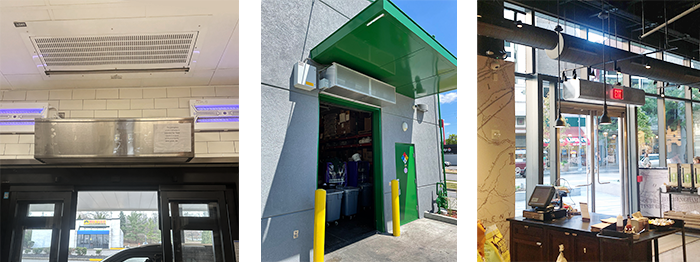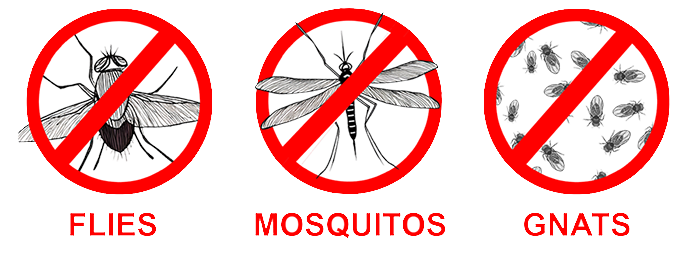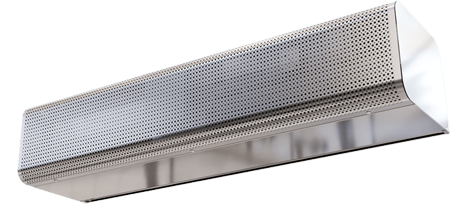
It’s hard to argue against the effectiveness of fly paper or indoor bug lights. Seeing the dead flies stuck to the paper or getting zapped in the light provides great visual and audio for a classy dining experience. The intrusion of flying pests can cause serious problems, from poor sanitation grades to negative online reviews. Fly paper, bug lights, sprays…these can all kill flies on the inside but why not prevent them from entering in the first place.
With the warmer weather, it’s time for a reminder on the effectiveness of air curtains for the prevention of flying insects in environments where cleanliness, hygiene, and comfort are critical — such as restaurants, hospitals, warehouses, and retail spaces.
Air Curtains generally are installed above entrances/entryways and direct a downward stream of air across the entirety of the opening. Powered Aire Air Curtains feature a plenum that pressurizes the air curtain before the air is discharged, which helps ensure total uniformity across the air curtain. This is critical for insect control as any “dead spots” can serve as entry points for flying insects.
This stream acts as an invisible barrier between the indoor and outdoor environments, allowing people and goods to pass through freely while preventing the entrance of outside air, dust, fumes, and — notably — insects. A properly installed air curtain can also pay for itself in a less than two years do to the energy savings it is able to create.
How Air Curtains Deter Insects: The principle behind air curtains is simple but effective when it comes to insects:
- Air Velocity and Pressure - Air curtains produce high-velocity air streams that have a greater degree of pressure than the surrounding areas. The stream, while passable for people and products, is too strong for smaller flying insects to penetrate – especially flies, mosquitos, gnats and other common pests.
- Prevents aroma of food from exiting and attracting flies - Many insects are attracted to the smells of food or warmth coming from inside a building. Air curtains help reduce the escape of odors and maintain indoor temperatures by sealing the air at the entrance. This decreases the sensory cues that attract insects, making them less likely to approach the building in the first place.
- Physical Deterrent - To an insect, the air curtain mimics a solid physical barrier. The sudden blast of air can be disorienting, causing flying pests to avoid the area altogether. In many cases, insects will bounce off the air stream or be redirected away from the entrance.

KEY APPLICATIONS WHERE FLYING INSECT DETERENCE IS CRITICAL
- Food Service Industry: Restaurants and kitchens rely on air curtains to keep insects out without compromising ventilation or access. This helps meet health code requirements and ensures a clean dining environment.
- Healthcare Facilities: Hospitals and clinics must maintain sterile conditions. Air curtains reduce the risk of disease-carrying insects entering these sensitive areas.
- Retail and Commercial Spaces: Grocery stores, bakeries, and supermarkets benefit from air curtains by preventing fruit flies and other pests from invading food displays.
- Warehouses and Industrial Facilities: High-traffic loading docks and service entrances are vulnerable to pests. Air curtains allow uninterrupted workflow while keeping insects at bay.
- Cleanrooms: Pharmaceutical, food service and other industries utilizing clean rooms for testing purposes must ensure the highest level of sanity/sterility for the purpose of testing. The introduction of unintended objects, like flies, can be detrimental to the processes.
Advantages Over Traditional Pest Control
- Non-Chemical Solution: Unlike insecticides, air curtains do not introduce toxic substances into the environment.
- Continuous Protection: While the door is open, the air curtain provides a constant and consistent barrier.
- Energy Efficiency: Modern air curtains are designed to minimize energy loss by separating conditioned indoor air from outdoor air, reducing the load on HVAC systems.
- Low Maintenance: Once installed, air curtains require minimal upkeep compared to traps or screens.

Air curtains provide a myriad of benefits from energy conservation to environmental separation. Their ability to act as a frontline defense against the infiltration of flying insects is a core benefit and what makes them such a popular choice for those desiring proactive prevention. By creating a high-speed, consistent air barrier, these devices offer a sustainable, hygienic, and cost-effective solution to one of the oldest challenges in public health and facility management. For businesses that prioritize cleanliness and customer satisfaction, investing in an air curtain system is a smart and practical move.
